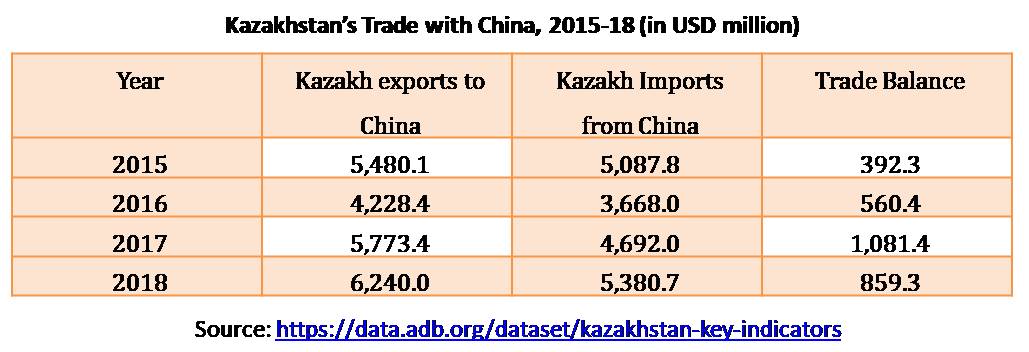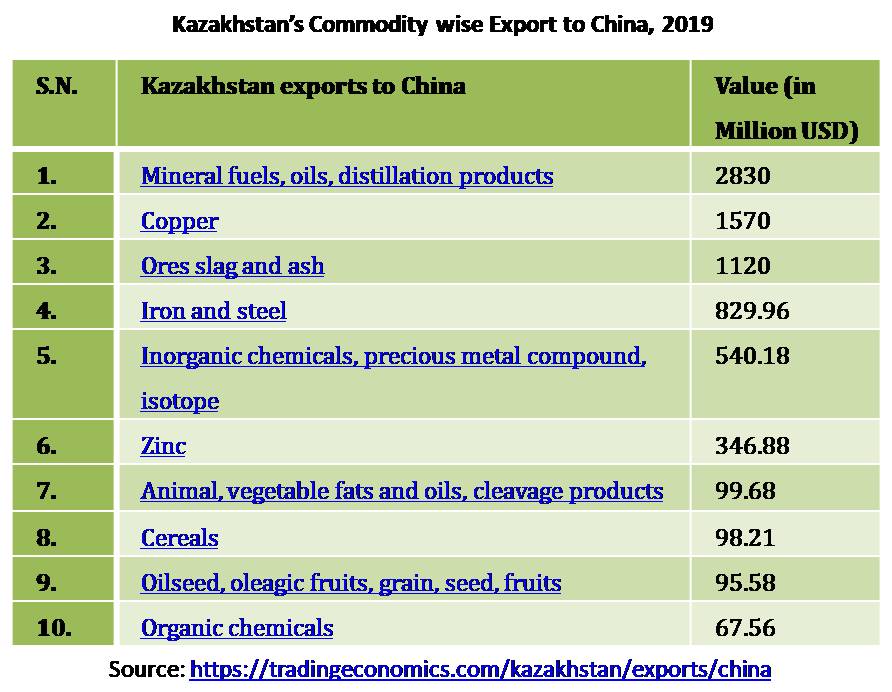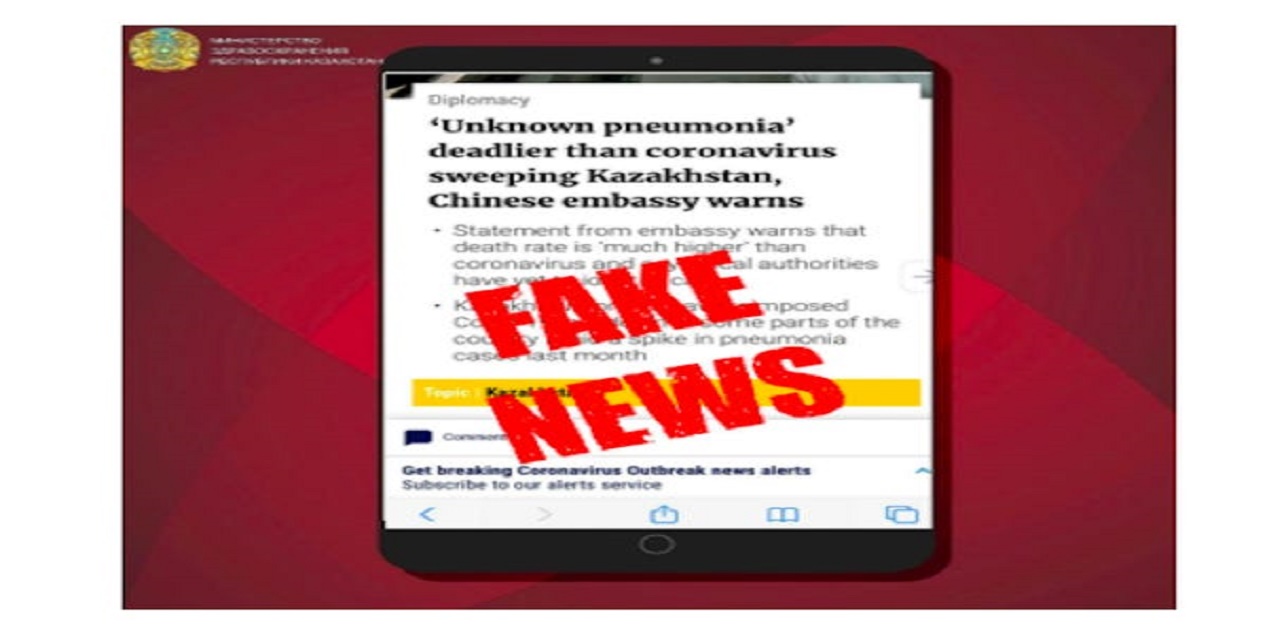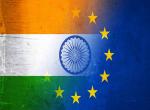Introduction
Kazakhstan has again become the victim of China’s sensationalist and maligned propaganda at the time when it is grappling with the rising number of COVID-19 cases in the country. On July 9, Chinese Embassy in Kazakhstan issued a statement1 on its official WeChat account to alert Chinese citizens living in Kazakhstan against the prevalence of an ‘Unknown Pneumonia’. The Chinese Embassy claimed that the unknown disease has a mortality rate far higher than novel coronavirus.2 Earlier on April 14, Kazakh Foreign Ministry summoned Chinese ambassador Zhang Xiao to formally protest against the publication of an article on a primary Chinese website, Sohu.com which questioned territorial integrity of Republic of Kazakhstan.3
In its statement, the Chinese Embassy had said that since mid-June, the cases of non-COVID pneumonia are on the rise in the Kazakh cities of Atyrau, Aqtobe and Shymkent. And within the six months of this year, it had killed a total of 1772 people. Also, there have been 628 pneumonia-related deaths in June only. Some Chinese citizens have also died due to this ‘Unknown Pneumonia’.4 Chinese Embassy also stated that the Health Ministry of Kazakhstan and other associated institutions are still conducting research on the pneumonia virus, but they have not been able to identify it. The Embassy also warned Chinese citizens in Kazakhstan to pay attention to the situation, to effectively raise awareness of prevention and to reduce the risk of infection. 5
Chinese media circulated this information as quickly as a flash. The information waves spread after an article by the South China Morning Post, quoting the message from the Chinese Embassy was published. Subsequently, global media turned their attention to the message and asked the Chinese Ministry of Foreign Affairs for comment. The CNN TV channel quoted the Chinese Foreign Ministry spokesman as saying that “Beijing would like more information” from the Kazakh side.6
China is a major investor in hydrocarbon resources of Kazakhstan. Central Asia-China Gas Pipeline, operational since 2010 delivers Turkmen gas to China. The pipeline starts at Gedaim on the border of Turkmenistan and Uzbekistan, running through central Uzbekistan and southern Kazakhstan, and ends at Horgos in China’s Xinjiang Uygur Autonomous Region. It is also one of the leading markets for its exports mainly dominated by commodities. Kazakhstan also makes money from Chinese goods carried across its territory to Europe.7 As clearly indicated from the below table, the balance of trade is in Kazakhstan’s favour.


Kazakhstan is also an integral part of China’s Belt and Road Initiative (BRI) and both countries share warm relations. There are around 1.5 million ethnic Kazakh Chinese population live in Xinjiang, making them the second-largest Muslim group in the region, after ethnic Uyghurs.8 China’s handling of ethnic minorities, including Kazakhs in its north-western province of Xinjiang, has been an issue of popular sentiments in Kazakhstan. However, at political and diplomatic levels, this issue has never resonated. Also, the increasing number of Chinese workers in Kazakhstan has led to anti-Chinese protests in Kazakhstan in recent past. But with the ever-increasing Chinese economic engagement with Kazakhstan, these issues have been unheard in political spheres.
China-Kazakhstan Cooperation on COVID-19
Since the outbreak of COVID-19 in Kazakhstan in mid-March, China extended help to curb the spread of the virus. It donated medical supplies to Kazakhstan. On April 9, 2020, a medical team from China reached to the Kazakh capital Nur-Sultan to assist Kazakh Government’s efforts to limit the menace of COVID-19. The 10-member crew also brought medical assistance, including 4,800 N95 respirators, 49,600 disposable surgical masks, 2,000 protection suits, two ventilators, and other medicines. 9 However, despite having strategic influence in Central Asia, China is often seen with suspicion in its ambitions in the region, especially among the local population.
Kazakhstan’s Response to Chinese Embassy’s Statement
Until now, there are 56,455 official cases of coronavirus reported so far in Kazakhstan with 264 deaths; 32,500 patients have recovered from the disease.10 A second wave of the virus outbreak has also been reported after the unlocking in May. Following this, Government has announced the second lockdown in the country on July 5 with strict quarantine measures. A strict quarantine has been enforced from July 11 and 12 in the cities such as Almaty. Public transport will not be operational, and non-essential businesses will also be closed. Unlike the previous lockdown, from March to May, when people were not allowed to leave their houses except to purchase food, this time, some businesses will be allowed to remain open. The local administration also announced that groups of no more than three people would be permitted in public. Public transport in Almaty paused for disinfection on July 6 and was resumed on July 7.11
Kazakhstan has categorized the Chinese claim of Kazakh cities being ravaged by the pneumonia outbreak, which is fatal than the coronavirus as ‘untrue and incorrect’. On July 10, in response to the Chinese claims, the Health Ministry of the Republic of Kazakhstan made a statement mentioning that a spike in cases was due to its including the classification of pneumonia cases where COVID-19 symptoms were present, but the patients tested negative, which is in line with World Health Organization guidelines. These cases included different types of bacterial, fungal and viral pneumonia including some of “unspecified etiology.”12 So, the information published by some Chinese media regarding a new kind of pneumonia in Kazakhstan is incorrect, the ministry said.13
After the statement made by the Chinese mission in Kazakhstan caught the attention of the world media, the message on the website of the Chinese Embassy was adjusted. Now, the Embassy’s warning does not contain the words ‘new’ and ‘unknown’ about ‘pneumonia’. Moreover, the proposal for high mortality from the disease has also been deleted. These rectifications were made on the next day when the Kazakh government issued a rejection of information about Chinese dissemination of misinformation. However, the statement issued by Kazakhstan’s Ministry of Health called the information false or fake, but it did not indicate the Chinese Embassy as being its source. The Ministry of Health said that the information comes from some Chinese media, the name of which was not given.14
Recurrence of China’s Aggressive Tendencies amidst Pandemic
The emergence of novel coronavirus in Hubei Province caused severe global criticism for China in the initial stage of the outbreak of this disease. China has been blamed for mishandling of the virus. It was also criticized for hiding the information and underplaying the severity of the virus. However, within a month or two, China has successfully limited the scope of the crisis and subsequently, began to actively pursue a new foreign policy to build a positive image of the country worldwide. Simultaneously a more aggressive and hyper nationalistic approach of China became visible to the world when digital propaganda against the territorial integrity of the neighbouring countries15 and the Chinese army intrusion into the Indian Territory occurred.16 China displayed similar irredentist tendencies concerning the South China Sea.17 Since the outbreak of the pandemic, the belligerence demonstrated by the Chinese embassies in different countries, Kazakhstan being one example is due to the impression that the aggressive style adopted by the Chinese diplomats ultimately appears to please President Xi Jinping.18
Does this suggest any Lessons for India?
India, while effectively fighting the spread of the virus, is helping many countries in the world to counter this pandemic. Kazakhstan is India’s major trade and investment partner in Central Asia. Among the Central Asian states, Kazakhstan was the first to receive medical supplies and humanitarian aid from India. On April 13, New Delhi sent medical supplies to Kazakhstan. While expressing his appreciation to PM Modi for extending help to Kazakhstan’s fight against coronavirus, President Toqayev stated that the gesture symbolizes a high level of friendship and solidarity between the two countries.19
Like Kazakhstan, India repeatedly has also been a victim of Chinese propaganda. It has been facing Chinese aggressive behaviour for quite a long time. And now when countries facing similar ill-founded attacks from China are taking these issues seriously, India needs to convert this into an opportunity to enhance its strategic influence. Although China has a strategic upper hand in Central Asia in terms of trade and investments; India’s goodwill in the region can potentially counter Chinese objectives in Central Asia. Central Asian countries might use the necessary assistance from India to contest the intimidating nature of China.
Conclusion
China’s pursuit of petty agenda against Kazakhstan can be seen as turning the limelight towards the other side amidst the global criticism. It seems less likely that Central Asian countries are in a position to directly confront Chinese propaganda at this point of time as the economic impact of the virus outbreak is immeasurable for these developing economies. Russia being the closet ally to the region, has also attuned with Chinese influence at least as it seems now. Western powers being the backer of democracy and human rights in the region are not enthusiastically entertained by these republics. India’s historical and cultural ties with the region give it advantage to leverage this goodwill. However, the way things have been going on at both ends, India needs to play a more assertive role in the region. The way India handled the recent confrontation with China will set a precedent globally and at the regional level as well.
Endnotes
- “Remind Chinese citizens in Kazakhstan to prevent pneumonia”, Embassy News, Chinese Embassy in Kazakhstan. July 9, 2020. http://kz.china-embassy.org/chn/sgxx/sgdt/t1796496.htm
- “Kazakhstan denies Chinese reports of pneumonia deadlier than COVID-19”, Wionews, July 10, 2020. https://www.wionews.com/world/kazakhstan-denies-chinese-reports-of-pneumonia-deadlier-than-covid-19-312174
- Pravesh Kumar Gupta, “Kazakhstan Protests Chinese Language Article questioning its Territorial Integrity”, Commentary, VIF, April 23, 2020. https://www.vifindia.org/2020/april/23/kazakhstan-protests-chinese-language-article-questioning-its-territorial-integrity
- “Remind Chinese citizens in Kazakhstan to prevent pneumonia”, Embassy News, Chinese Embassy in Kazakhstan. July 9, 2020. http://kz.china-embassy.org/chn/sgxx/sgdt/t1796496.htm
- Ibid.
- Jessie Yeung, Philip Wang and Martin Goillandeau, “Kazakhstan denies Chinese government report that country has 'unknown pneumonia' outbreak more deadly than Covid-19” By, CNN News, July 10, 2020. https://edition.cnn.com/2020/07/10/asia/kazakhstan-pneumonia-intl-hnk-scli-scn/index.html
- “Kazakhstan summons Chinese ambassador in protest over article”, World News, Reuters, April 14, 2020. https://www.reuters.com/article/us-kazakhstan-china/kazakhstan-summons-chinese-ambassador-in-protest-over-article-idUSKCN21W1AH
- Reid Standish, “Our Government Doesn’t Want to Spoil Relations with China”, The Atlantic, September 3, 2019. https://www.theatlantic.com/international/archive/2019/09/china-xinjiang-uighur-kazakhstan/597106/#:~:text=Nearly%201.5%20million%20ethnic%20Kazakh,in%20the%20region%2C%20after%20Uighurs.
- Pravesh Kumar Gupta, “Kazakhstan Protests Chinese Language Article questioning its Territorial Integrity”, Commentray, VIF, April 23, 2020. https://www.vifindia.org/2020/april/23/kazakhstan-protests-chinese-language-article-questioning-its-territorial-integrity
- https://www.worldometers.info/coronavirus/country/kazakhstan/
- “Dashboard: Coronavirus in Eurasia”, Eurasia Net, July 10, 2020. https://eurasianet.org/dashboard-coronavirus-in-eurasia
- Jessie Yeung, Philip Wang and Martin Goillandeau, “Kazakhstan denies Chinese government report that country has 'unknown pneumonia' outbreak more deadly than Covid-19” By, CNN News, July 10, 2020. https://edition.cnn.com/2020/07/10/asia/kazakhstan-pneumonia-intl-hnk-scli-scn/index.html
- “Kazakhstan’s Health Ministry rejects Chinese claim of new deadly virus”, The Times of Central Asia, July 11, 2020. https://www.timesca.com/index.php/news/22679-kazakhstan-s-health-ministry-rejects-chinese-claim-of-new-deadly-virus
- “Chinese Embassy amends report on outbreak of pneumonia in Kazakhstan”, RFE/RL, July 10, 2020. https://rus.azattyq.org/a/30719735.html
- Mimi Lau, China shuts down 153 social media accounts for carrying fake nationalistic content, SCMP, 18 April 2020. https://www.scmp.com/news/china/politics/article/3080551/china-shuts-down-153-social-media-accounts-carrying-fake
- “India-China Border News highlights: China amassed troops along LAC since early May, violating agreements, says MEA”, The Indian Express, June 26, 2020. https://indianexpress.com/article/india/india-china-border-news-live-updates-galwan-ladakh-6473414/
- S. D. Pradhan, “South China Sea: Assessing Chinese historical justification of nine dashed line”, Times of India Blog, June 5 2020.https://timesofindia.indiatimes.com/blogs/ChanakyaCode/south-china-sea-assessing-chinese-historical-justification-of-nine-dashed-line/
- James Palmer, “Why Chinese Embassies Have Embraced Aggressive Diplomacy, China Brief, Foreign Policy, April 15, 2020. https://foreignpolicy.com/2020/04/15/chinese-embassies-embrace-aggressive-diplomacy-coronavirus-pandemic-misinformation/
- Pravesh Kumar Gupta, “India’s Medical Diplomacy in Central Asia amid COVID-19”, Diplomacy and Beyond Plus, June 25 2020. https://diplomacybeyond.com/articles/indias-medical-diplomacy-in-central-asia-amid-covid-19/#_edn2
(The paper is the author’s individual scholastic articulation. The author certifies that the article/paper is original in content, unpublished and it has not been submitted for publication/web upload elsewhere, and that the facts and figures quoted are duly referenced, as needed, and are believed to be correct). (The paper does not necessarily represent the organisational stance... More >>
Image Source: https://i.insider.com/5f083a6eaee6a8665c5c37a5?width=600&format=jpeg&auto=webp











Post new comment